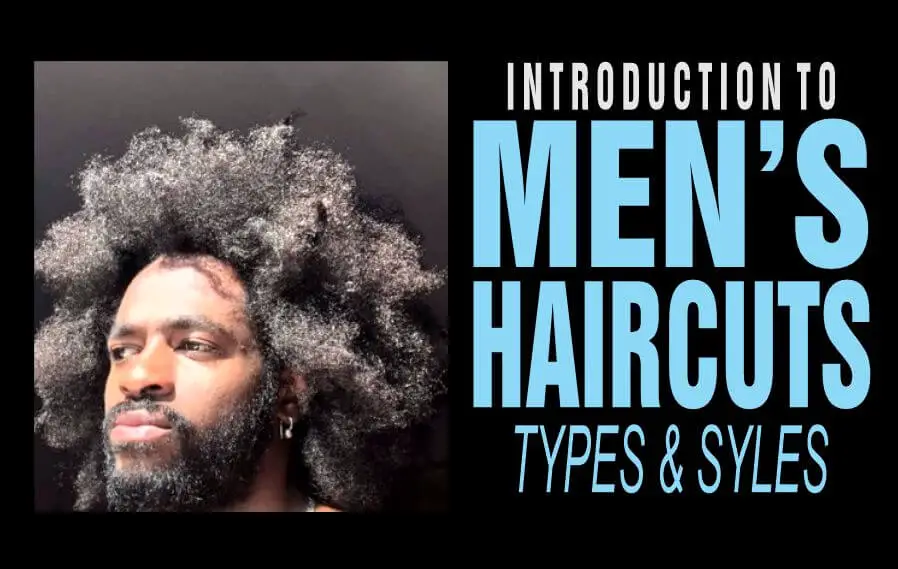Last updated on February 11th, 2024 at 10:11 am
Men’s haircuts and style play a vital role in men’s fashion, as it has the power to enhance one’s overall appearance and elevate style.
Over the years, there has been a significant increase in the interest and exploration of various men’s hairstyles.
From classic cuts to modern trends, the possibilities are endless.
This growing fascination with men’s hair styles highlights the importance of understanding different haircuts and styles.
We have brought to you a comprehensive guide to several men’s haircuts and styles, including hair types, classic men’s hairstyles, and medium and long hair options.
At the end of this article, you will be able to distinguish between these haircuts and have minimal effort in choosing your best according to your hair type and face shape.
Recommended: Introduction to Proper Grooming for Men
Table of Contents
- Understanding Men’s Hair Types
- Other Factors Used in Determining Hair Type
- Men’s Hair Types Chart
- How Hair Type Affects Men’s Haircuts Options
- Tips for Determining Hair Type
- Classic Men’s Haircuts
- Popular Men’s Haircut Trends
- Men’s Haircut Trends
- Selecting the Right Men’s Haircut
- Frequently Asked Questions
- Conclusion
Understanding Men’s Hair Types
Men, like women, have various hair types that can greatly affect how their hair looks and behaves because of their distinct properties.
By understanding men’s hair types, men can better care for their hair and choose hairstyles and products that suit their needs.
The four main types of men’s hair are straight, wavy, curly, and coily/kinky hair.
Let’s describe them one after the other in detail:
Straight Hair
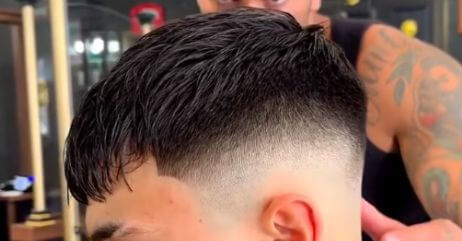
Straight hair is the most common men’s hair type. It is characterized by its smooth and sleek appearance with minimal texture.
Straight hair tends to be shiny, silky, and easily manageable. It typically doesn’t frizz or tangle easily and can be styled in various ways.
However, straight hair can also be prone to oiliness and can appear flat if not styled properly.
Men with straight hair can experiment with different haircuts and hairstyles to achieve different looks, from short and neat to longer and more textured styles.
Related: Mastering Men’s Hair Care Routine
Wavy Hair
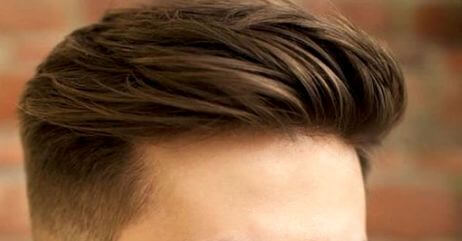
Wavy hair, as the name suggests is one of the men’s hair types. It features a slight wave pattern that falls between straight and curly.
This hair type has more texture and volume compared to straight hair.
Wavy hair can range from subtle waves to more defined S-shaped curls. It is prone to frizz, especially in humid conditions, but can also hold styles well with the right products.
Men with wavy hair can opt for layered haircuts to enhance the natural waves while keeping the hair manageable and styled.
Related: The Buzz Cut Taper Men’s Hairstyle
Curly Hair

Curly hair is characterized by its more pronounced curl pattern and tends to be thicker and fuller than straight or wavy hair.
It ranges from loose, bouncy curls to tight spiral curls. Curly hair is known to be more prone to frizz, dryness, and tangling.
Men with curly hair often struggle with managing their hair due to its natural tendency to shrink and become unruly.
Proper moisture, regular conditioning, and using curl-specific products are essential to maintain healthy, defined curls.
Curly-haired men have a wide array of styling options, from embracing their natural curls to having shorter or longer styles that suit their preferences.
Recommended: Tips for Taking Care of Your Scalp
Coily/Kinky Hair
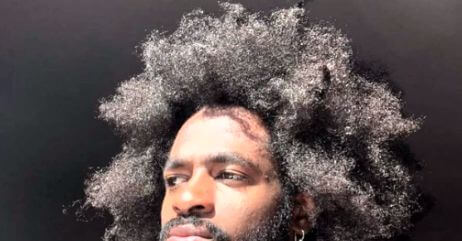
Coily or kinky hair is tightly coiled and has a distinct zigzag pattern. This hair type is characterized by its tight curls, also known as afro-textured hair.
It tends to be very thick, dense, and fragile. Coily/kinky hair can shrink significantly in length when dry and is more prone to dryness and breakage.
Regular moisturizing and deep conditioning are vital in maintaining moisture and preventing breakage.
Men with coily/kinky hair can choose to embrace their natural texture or opt for various hairstyles like afros, locs, or twist-outs.
Other Factors Used in Determining Hair Type
Thick Hair
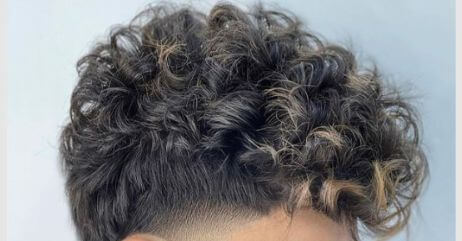
Thick hair, characterized by a high density of hair follicles, offers a voluminous and robust appearance.
This type is known for its fullness and versatility, allowing for various styling options.
Men with thick hair often opt for layered cuts, pompadours, or textured styles to showcase the richness of their hair.
The challenge lies in managing the thickness, requiring regular maintenance to prevent the style from becoming overly bulky.
However, when properly styled, thick hair can create a striking and impactful look, adding depth and dimension to the overall aesthetic.
Fine Hair
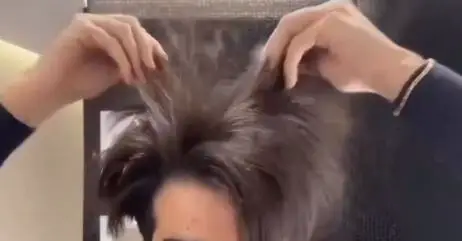
Fine hair, comprised of smaller and thinner strands, lends itself to a sleek and polished appearance.
While it may lack the density of thick hair, fine hair offers a smooth and refined texture.
Men with fine hair often opt for shorter styles such as buzz cuts or slicked-back looks to maximize neatness.
The challenge lies in avoiding styles that may make the hair appear limp.
With the right cut and styling products, fine hair can exude a clean and sophisticated vibe, allowing for a range of classic and contemporary hairstyles that highlight its inherent sleekness.
Combination Hair
Combination hair refers to a blend of different textures or thicknesses throughout the scalp.
This type presents a unique challenge as individuals may have areas of straight, wavy, or curly hair.
Men with combination hair benefit from hairstyles that balance the diverse textures, creating a harmonious and cohesive look.
This may involve customized cuts that cater to the dominant characteristics in specific regions.
Understanding how various sections interact allows for personalized styling choices, ensuring a well-integrated appearance.
While versatile, managing combination hair requires a tailored approach to address the distinctive needs of each hair type present on the scalp.
Men’s Hair Types Chart
A men’s hair types chart is a visual representation that categorizes different hair textures and types commonly found in men.
It helps individuals understand their own hair type and provides guidance on how to care for and style their hair accordingly.
The chart typically includes categories such as straight, wavy, curly, and kinky hair, with subcategories that further describe the specific characteristics of each type.
It may also provide information on the thickness, density, and porosity of the hair.
Understanding your hair type through a hair types chart can assist in selecting appropriate products, hairstyles, and grooming techniques to enhance the natural beauty of your hair.
How Hair Type Affects Men’s Haircuts Options
Men’s hair types play a crucial role in determining suitable hairstyle options.
Hair type is primarily influenced by factors such as thickness, texture, and curl pattern.
Understanding these characteristics allows men to choose hairstyles that complement their natural hair, enhance their overall appearance, and are easier to maintain.
Here’s how different hair types affect hairstyle options:
Straight Hair
Advantages: Straight hair tends to be versatile and can suit various styles. It often looks polished and can be easy to manage.
Hairstyle Options: Pompadours, slick backs, crew cuts, and undercuts are popular choices for straight hair.
Wavy Hair
Advantages: Wavy hair adds texture and volume, providing a relaxed and natural appearance.
Hairstyle Options: Textured crops, quiffs, and messy styles work well with wavy hair, as they enhance its natural movement.
Curly Hair
Advantages: Curly hair offers a unique and dynamic look. It can create a sense of volume and depth.
Hairstyle Options: Taper fades, curls with fades, and longer curls with defined shapes are popular for men with curly hair.
Related: Older Men’s Hair Styles
Coiled or Kinky Hair
Advantages: Coiled or kinky hair has a distinct texture that stands out and can create bold, expressive styles.
Hairstyle Options: Afro styles, twists, and dreads are common choices for men with coiled or kinky hair.
Thick Hair
Advantages: Thick hair provides volume and allows for various styling options.
Hairstyle Options: Layered cuts, pompadours, and textured styles work well for men with thick hair, as they showcase the hair’s fullness.
Fine Hair
Advantages: Fine hair is generally more manageable and can give a sleek and polished appearance.
Hairstyle Options: Short crops, buzz cuts, and slicked-back styles are suitable for men with fine hair as they maximize its neat and refined look.
Combination Hair
Advantages: Some men may have a combination of textures or thickness throughout their hair.
Hairstyle Options: Depending on the dominant characteristics, men can choose styles that cater to the varied aspects of their hair, ensuring a balanced and cohesive look.
Hair Density
Advantages: Hair density refers to the amount of hair on the scalp. It influences overall fullness and can impact styling choices.
Hairstyle Options: For high-density hair, voluminous styles like pompadours or textured quiffs can work well.
For lower density, shorter styles may provide a cleaner appearance.
Tips for Determining Hair Type
Determining men’s hair types is crucial for selecting appropriate hairstyles and hair care routines.
Here are tips to help identify different hair types:
Observation: Examine the natural state of your hair after washing and air-drying. Note any curl patterns, waves, or straightness.
Texture Test: Run your fingers through your hair. Fine hair feels smoother, while coarse or thick hair feels rougher. The texture can range from silky to coarse.
Density Check: Assess the density by checking how closely the strands are packed. Thick hair appears fuller, while fine hair may seem sparser.
Curl Pattern: Identify the curl pattern by observing if your hair is straight, wavy, curly, coiled, or kinky. This helps in choosing suitable hairstyles.
Porosity Assessment: Determine hair porosity by observing how quickly your hair absorbs and retains moisture. Low porosity hair resists moisture, while high porosity hair readily absorbs it.
Shine and Luster: Observe the natural shine of your hair. Fine hair tends to shine more, while coarse or curly hair may have a more matte appearance.
Elasticity Test: Test your hair’s elasticity by pulling a strand gently. Healthy hair is elastic, able to stretch and bounce back to its original length without breaking or losing its shape. If it breaks easily, it might be damaged.
Diameter Measurement: Fine hair has a smaller diameter, while thick hair has a larger one. Compare a single strand of hair to a piece of sewing thread for reference.
Consult a Stylist: Professional hairstylists can provide valuable insights into your hair type. They are trained to recognize different textures and can recommend suitable styles and products.
Observe Growth Patterns: Pay attention to how your hair grows, especially in areas like the crown and hairline. Different growth patterns may affect the suitability of certain hairstyles.
Environmental Factors: Consider external factors like humidity, which can impact the appearance of your hair. For instance, wavy or curly hair may become more pronounced in humid conditions.
Previous Hairstyles: Reflect on past hairstyles that worked well or posed challenges. This can provide clues about your hair type and help in making informed choices.
Trial and Error: Experiment with different hair care products and styles to see what works best. This hands-on approach can provide valuable insights into your hair’s behavior.
Remember that individuals may have a combination of characteristics, making their hair type unique.
Understanding your hair type is the first step in adopting a personalized approach to hair care and styling.
Classic Men’s Haircuts
Classic men’s haircuts are timeless hairstyles that have been popular for decades.
These haircuts are typically clean, well-groomed, and versatile, suiting men of all ages and professions.
Classic men’s haircuts exude a sense of sophistication and can be easily styled for both formal and casual occasions.
In addition, these haircuts often prioritize simplicity, low maintenance, and a clean appearance.
Men’s Short Haircut Options
Crew Cut: The crew cut is a popular short haircut where the hair on the top is kept longer, typically an inch or two, and gradually fades to a shorter Length extends to the sides and back of the head. This versatile haircut can be styled in various ways, and its length allows for easy maintenance and quick styling.
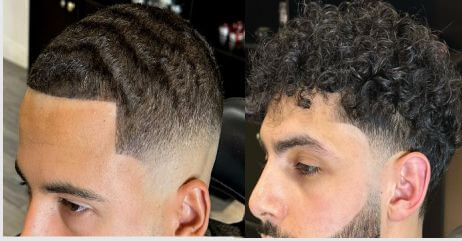
Buzz Cut: The buzz cut is an extremely short haircut where the hair is uniformly trimmed to an even length, usually very close to the scalp. This low-maintenance haircut requires minimal styling and is perfect for those who prefer a clean and effortlessly cool look.
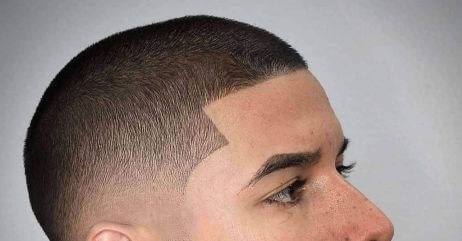
High and Tight Fade: The high and tight fade is a short haircut that features shaved sides and back of the head, gradually blending into longer hair on the top. This style creates a sharp contrast between the closely shaved sections and the longer hair, providing a refined and polished appearance. The high and tight fade offers a modern twist to the classic crew cut and is favored by many men for its clean yet stylish aesthetic.
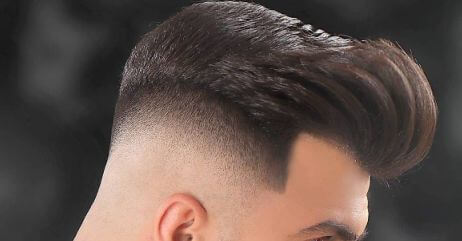
Men’s Medium Haircut Options
The Side Part: The side part haircut is a timeless choice for men with medium hair. It involves creating a distinct parting on one side of the head and combing the hair in a sleek and polished manner. This style exudes sophistication and can be easily paired with both formal and casual attire, making it a versatile choice for any occasion.

The Quiff: The quiff haircut is a popular choice for men seeking a stylish and edgy look. It features longer hair on top that is styled upwards and backwards, creating a voluminous and textured appearance. This hairstyle adds height and definition to the hair, giving a confident and modern vibe. It requires some product and styling time to achieve the desired volume and hold.
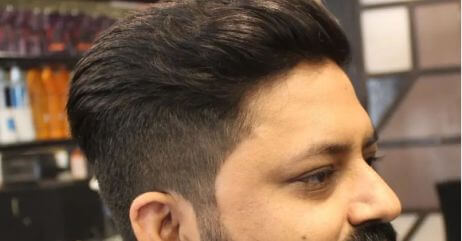
The Pompadour: The pompadour hairstyle is a classic and bold option for men. It involves keeping the hair longer on top and styling it upwards and back, while the sides are typically shorter. This haircut creates a dramatic and elegant look, perfect for those who want to make a statement. It requires some styling product and effort to maintain its shape and volume throughout the day.

The Undercut: The undercut is a trendy and daring haircut choice for men with medium hair. It involves shaving or trimming the sides and back of the head very short, while leaving the hair on top longer and styled in various ways. This versatile style allows for countless possibilities, such as combining it with a side part, pompadour or quiff. The undercut offers a bold and modern appearance, emphasizing the contrast between the longer top and shorter sides.
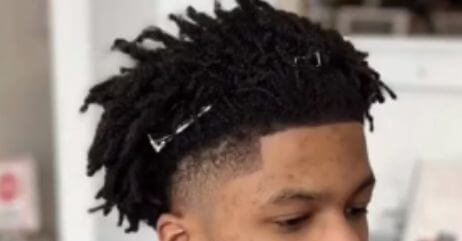
The Taper Fade: The taper fade haircut involves gradually decreasing the length of the hair from the top to the sides and back, creating a smooth and blended transition. This versatile style can be customized to suit individual preferences, with options like low, mid, or high fades. The taper fade offers a clean and polished look, suitable for both formal and casual occasions. It requires regular maintenance to keep the fade sharp and well-structured.
Men’s Long Haircut Options
Man Bun: The man bun is a popular long hair option where the hair is gathered and tied into a bun at the back of the head. It offers a stylish and versatile look, suitable for both casual and formal occasions. The man bun can be worn high or low, and it adds a touch of sophistication to any outfit.
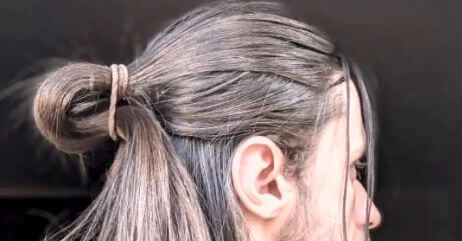
Undercut Ponytail: The undercut ponytail combines the edginess of an undercut with the practicality of a ponytail. The sides and back of the head are shaved or cut very short, while the top is left long and tied into a ponytail. This haircut offers a bold and modern look, with the contrast between the shaved sides and the flowing ponytail creating a unique style.
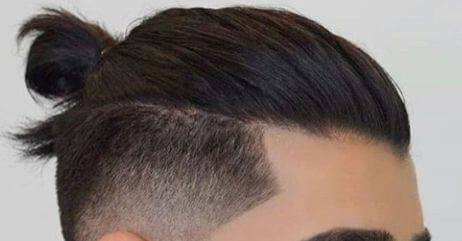
Shoulder-length Layered Cut: The shoulder-length layered cut is a classic choice for men with long hair. It involves cutting the hair to shoulder length and adding layers throughout to create movement and texture. This haircut is versatile and suits various face shapes and hair types. It offers a balanced and effortless look, allowing for easy styling and a relaxed appearance.
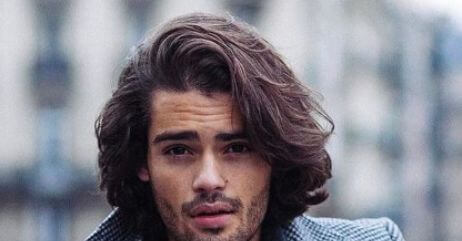
Surfer Hair: Surfer hair is a laid-back and beachy style that mimics the natural texture and volume of hair after spending time in the ocean. It typically involves growing out the hair to medium or long length and allowing it to flow freely. Surfer hair is characterized by loose waves or curls, a slightly messy appearance, and a carefree vibe. It’s a low-maintenance option that exudes a cool and effortless charm.
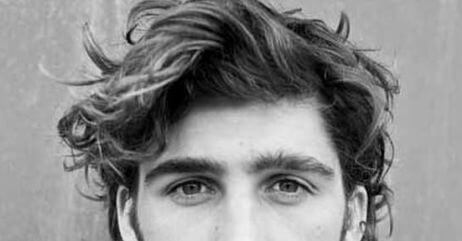
Classic Slicked Back: The classic slicked back hairstyle is a timeless and sophisticated choice for men with long hair. It involves combing the hair back and applying a styling product to create a sleek and polished look. This haircut works well for formal occasions or when you want to make a refined statement. It adds a touch of elegance and can be customized with different variations, such as a side part or a fade on the sides.
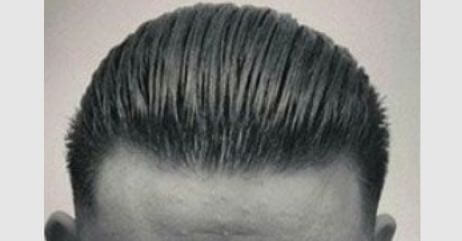
Popular Men’s Haircut Trends
Taper Fade: The taper fade is a popular men’s hair trend where the hair gradually decreases in length from the top to the sides and back. It creates a clean and polished look, with a seamless transition between different hair lengths. The taper fade can be customized with various styles, such as a high, mid, or low fade, allowing for versatility and personalization.
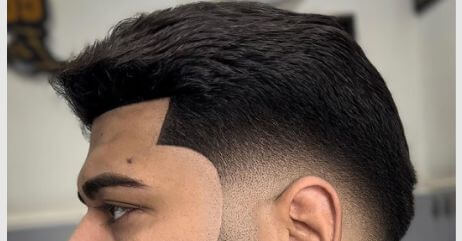
Textured Crop: The textured crop is a trendy hairstyle that involves cutting the hair short on the sides and back, while leaving the top slightly longer. The hair is then styled with texture and movement, often using a matte styling product. This haircut offers a modern and effortless look, with a focus on natural texture and a tousled appearance.
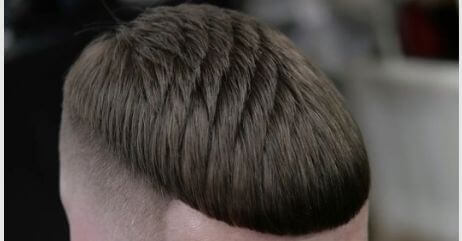
Slicked-back Undercut: The slicked-back undercut combines the sleekness of a slicked-back hairstyle with the edginess of an undercut. The sides and back are shaved or cut very short, while the top is left longer and styled back with a styling product for a polished and refined look. This hairstyle exudes confidence and sophistication, making it a popular choice for both formal and casual settings.
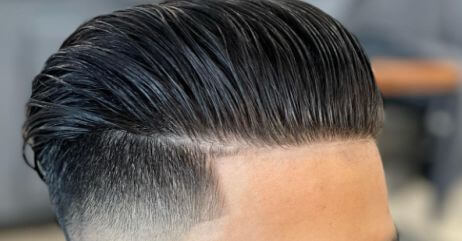
Fade with Hard Part: The fade with hard part is a stylish haircut that features a fade on the sides and back, gradually transitioning from short to longer hair. A hard part is created by shaving a distinct line into the hair, adding a sharp and defined element to the style. This haircut offers a clean and modern appearance, with the hard part adding a touch of uniqueness and precision.
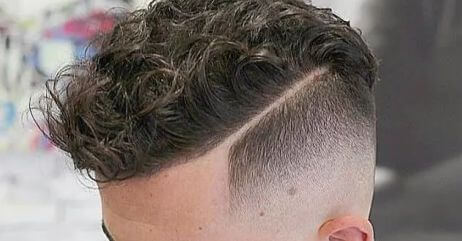
Faux Hawk: The faux hawk is a versatile and bold hairstyle that mimics the look of a mohawk without shaving the sides completely. The hair on the sides is cut shorter, while the hair on the top is left longer and styled upwards to create a central ridge. This haircut offers a rebellious and edgy vibe, allowing for different variations and styling options.
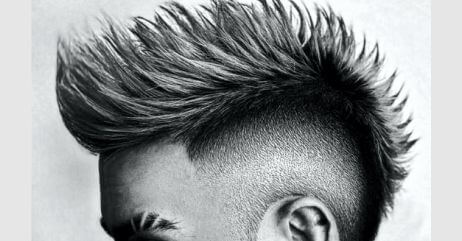
Mohawk Variations: Mohawk variations refer to different styles derived from the classic mohawk haircut. The traditional mohawk involves shaving the sides of the head and leaving a strip of longer hair in the middle. However, variations can include different hair lengths, fades, or designs on the sides. Mohawk variations offer a bold and attention-grabbing look, allowing for creativity and personal expression.
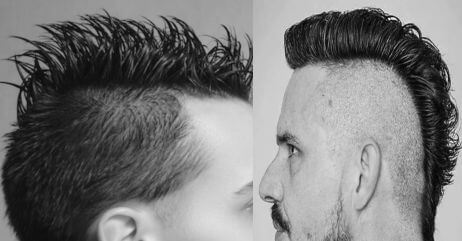
Men’s Haircut Trends
Men’s haircut trends are constantly evolving, offering a wide range of stylish options for every individual.
From classic styles to bold and modern cuts, here are the latest trends that are shaping the world of men’s hairstyles.
Current Popular Styles
The current popular styles for men’s haircuts include various options that cater to different preferences and hair types.
Some of the popular styles include the textured crop, undercut with longer top, taper fade, classic slicked-back, and the buzz cut.
These styles offer versatility, allowing men to express their individuality and personal style.
The emphasis is on clean lines, natural texture, and low-maintenance looks that are both stylish and practical.
Emerging Trends in Men’s Haircuts
Emerging trends in men’s haircuts often push the boundaries and offer unique and creative options.
Some emerging trends include the mullet revival, where the hair is short on the sides and long in the back, the shaggy and layered cuts with a retro vibe, and the modern bowl cut that combines a classic shape with a contemporary twist.
These emerging trends showcase a desire for experimentation and individuality in men’s hairstyles.
Celebrities and Influencers Setting the Trends
Celebrities and influencers play a significant role in setting trends for men’s haircuts.
Their hairstyles are often emulated and admired by many.
For example, celebrities like Brad Pitt, David Beckham, and Timothée Chalamet have influenced popular styles such as the textured quiff, the pompadour, and the side-swept undercut.
Social media platforms like Instagram and TikTok also contribute to the dissemination of trends, with influencers showcasing their unique hairstyles and inspiring others to try new looks.
Selecting the Right Men’s Haircut
Choosing the right men’s haircut is essential for achieving a stylish and confident look.
With numerous options available, let’s look into the key factors to consider when selecting a haircut that suits your personal style, preferences, and maintenance requirements.
Considering Personal Style and Preferences
When choosing a men’s haircut, it’s important to consider your personal style and preferences.
Think about the image you want to project and how the haircut aligns with your overall aesthetic.
Consider factors such as whether you prefer a more classic or trendy look, how much time you’re willing to spend on styling, and whether you want a low-maintenance or high-maintenance haircut.
Your hairstyle should mirror your personality, instilling confidence and providing comfort, ensuring you feel at ease and self-assured.
Seeking Professional Advice
It can be helpful to seek professional advice when selecting a men’s haircut.
Barbers and hairstylists have expertise in understanding different hair types, face shapes, and styles that would suit you best.
They can provide recommendations based on your hair texture, face shape, and lifestyle.
Communicate your preferences and ask for their input to ensure you make an informed decision.
A professional can also guide you on how to maintain and style your chosen haircut.
Understanding Maintenance Requirements
Before settling on a men’s haircut, it’s essential to understand the maintenance requirements it entails.
Some haircuts may require regular trims to maintain their shape, while others may need styling products or specific techniques to achieve the desired look.
Consider your willingness to invest time and effort into maintaining the haircut. If you prefer a low-maintenance option, opt for a style that requires minimal styling and upkeep.
Understanding the maintenance requirements will help you choose a haircut that fits your lifestyle and grooming routine.
Frequently Asked Questions
What are the styles of haircuts for men?
The styles of haircuts for men can vary from short and clean cut styles like buzz cuts and crew cuts, to longer styles like pompadours and undercuts.
What are the 4 types of haircuts?
The four types of haircuts include short haircuts (like buzz cuts and crew cuts), medium-length haircuts (such as fades and textured cuts), long haircuts (like man buns and shags), and specialty haircuts (such as Mohawks and comb overs).
What are the 5 basic haircuts for men?
The five basic haircuts for men include the buzz cut, crew cut, fade, textured cut, and slicked-back style.
What is hair cut and style?
Haircut and style refer to two different aspects. A haircut involves trimming or styling hair according to a desired length or shape, while hairstyling involves using products and tools to arrange the hair in a desired fashion.
Conclusion
Men’s hairstyles play a significant role in shaping one’s overall appearance and self-expression.
We have explored various men’s haircuts and styles, highlighting their versatility and ability to reflect personal style and preferences.
It is crucial to understand the importance of selecting a haircut that aligns with your personality and lifestyle.
Additionally, we encourage you to step out of your comfort zone and experiment with different styles to discover new looks that enhance your confidence and individuality.
Remember to seek professional advice, consider maintenance requirements, and most importantly, have fun with your hair.
Embrace the power of a well-chosen haircut and let it be a reflection of your unique identity.
References:
Pious Clements, an influential and experienced writer, is prolific on social issues and challenges prevailing gender roles on his website, “The Conducts of Life”. With an unwavering commitment to inclusivity and equality, Pious fearlessly unpacks societal norms and sheds light on the overlooked complexities.
His eloquent analyses and thought-provoking articles make him a trusted voice amplifying narratives that have long been silenced. Join Pious on his journey as he strives to reshape the world, one word at a time.
